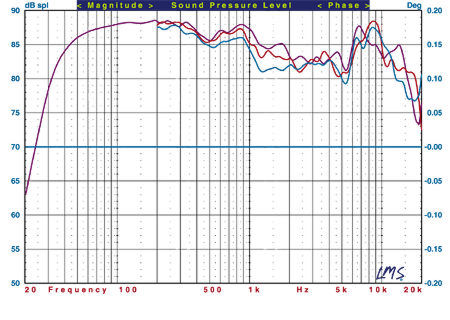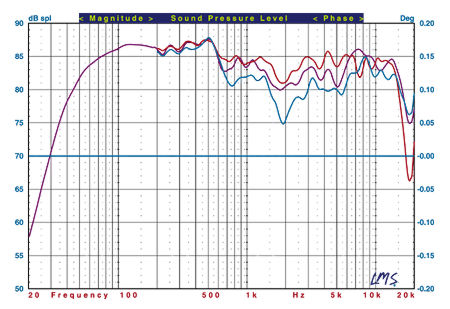Mirage Omni 250 Surround Speaker System Measurements
The Omni 250's sensitivity measured approximately 88dB/W/m through the midrange. Its ported cabinet is tuned to approximately 40Hz. Its minimum impedance is 4.4ohms at 216Hz; we would rate its nominal impedance at 6ohms. Overall, any good amplifier capable of performing comfortably into a 4ohms load should have no trouble driving this speaker.
The 250's pseudo-anechoic response at tweeter height, averaged over a +/-30° forward horizontal angle and combined with the nearfield responses of the woofers and port, is shown in Fig.1 (violet). The useful bass extends down to approximately 30Hz (–10dB relative to the output at 100Hz). Looking at the curve, you might suspect that the speaker will sound quite bright due to the prominent rise in response centered around 6.5kHz. The fact that this wasn't an issue in the listening tests may have been due to the dip in the response extending from 1kHz to just under 6kHz. The net audible result was a slightly laid-back sound rather than a bright treble. Only at higher levels did the mid-treble rise come into play, with a slight hardening of the sound. The response is unusually uniform across the full horizontal angle we measure, clearly a result of the speaker's multidirectional design. Had we gone beyond 60°, we likely would have obtained a similar response at even wider angles.

Fig. 1
Fig.2 again shows the Omni 250's averaged horizontal front response (violet), plus the vertical responses taken at +15° (red) and –15° (blue) relative to the tweeter. Note that the response dip in the low treble fills in at listening positions slightly above the tweeter. The response ripples that remain are undoubtedly due to reflections from the dispersion devices in the Omniguide. The response below tweeter height suggests that you don't want to listen to this speaker when seated on the floor.

Fig. 2
The frequency response of any speaker with an atypical dispersion pattern—whether omnidirectional, bipolar, or dipolar—is difficult to measure in a meaningful way. The fact that the low-treble dip in the 250's averaged near-on-axis response fills in at some angles suggests that the speaker's room response will be flatter than that shown in the curves. That's the way I heard it. Nevertheless, the overall response of the Omni 250, as measured, still falls within a +/-4dB window from 33Hz to 15kHz.
The port on the Omni 60, used as a center channel for most of the listening tests, is tuned to about 45Hz. I would rate its nominal impedance at 5ohms. Its impedance remained below 4ohms from 150 to 800Hz, dropping to a minimum of 3.6ohms from 215 to 550Hz. The speaker's sensitivity measured approximately 86dB/W/m; we would judge it to be slightly more difficult to drive than average, though, as with the Omni 250, a good amplifier with 4ohm drive capability should be fine.
The measured front horizontal response of the Omni 60, taken on the tweeter axis and averaged in the same manner as described above for the Omni 250, is shown in Fig.3 (violet). The useful bass extends to approximately 38Hz (–10dB relative to the output at 120Hz). The on- and off-axis curves (Fig.4) are very similar to those of the Omni 250, apart from a less extended bass, and the same frequency-response comments apply.

Fig. 3

Fig. 4
Finally, the Omni CC measured a nominal 4ohms impedance, with minimum values of 3ohms at 932Hz and 3.4ohms at 50Hz. The ported cabinet is tuned to 50Hz, and we would rate the CC's sensitivity at 85dB/W/m. Its response curves, both on- and off-axis (not shown), were not significantly different from those of the Omni 250 and 60.—TJN
- Log in or register to post comments




































































